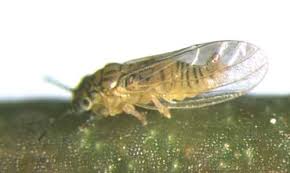
Psyllid adult
Psyllids, sometimes called jumping plant lice, are common pests associated with fruit trees. There are over 100 species of these tiny jumping creatures known in North America. They prefer to feed on both the leaves of trees and small fruits, though they are also sometimes found on tomato and potato plants.
They feed by piercing the outer surface of leaves and extracting the cell sap inside. The honeydew they secrete can cause molds to grow and they are also known to carry and transmit viral diseases.
How to Identify Psyllids
Adults are about 1/10 of an inch long with a reddish brown color, transparent wings and strong legs, which they use to jump. They are very active insects and will usually jump or fly away if disturbed. Psyllid nymphs have a flat elliptical shape, almost scale like. They are considerably less active than adults and are usually found in larger numbers on the underside of leaves. Just hatched nymphs have a yellowish color but they become green as they mature.
The Psyllid Life Cycle
Adults will spend the winter in cracks and crevices in tree trunks. They will become active in early spring and begin mating. Females will deposit eggs in crevices along tree trunks, in newly forming buds, and on leaves when foliage has begun to grow. Depending on the environment, eggs will begin to hatch anywhere from four to fifteen days after they’ve been laid. Nymphs will reach adulthood about two to three weeks after hatching. Depending on the exact species, anywhere from one to five generations can be produced during the year.
How To Control Psyllids
Horticultural oil – Horticultural oils will destroy overwintering adults as well as eggs if applied in the spring. The oil will suffocate both insects and eggs before they have the chance to become active.
Beneficial insects – Ladybugs and lacewings are both strong predators of psyllids. To achieve the best results, it’s important to release these garden helpers when pest levels are low. If there’s already a large infestation, they will not be able to keep up.
Natural pesticides – If you’ve already got a large infestation, you can bring it under control by first using short-lived natural pesticides to bring numbers down and then releasing predatory insects to maintain results.
Insecticidal soap – This pest killer contains ingredients which will penetrate and damage the outer shells of soft-bodied insects. The end result is that the insects will dehydrate and die within a few hours. Insecticidal soaps must make direct contact with the insects to be effective. You may need to re-apply this treatment several times over a few days if you’ve got a large problem.
Organic pesticides – As a last resort for a problem that seems to be completely out of hand, stronger organic pesticides can be used to reduce the pest population. Of course, if you plan to consume the fruits or vegetables that you are treating, be sure to read all pesticide labels and warnings and follow instructions carefully to make sure any consumables will be safe to eat.
Employ Multiple Defenses
The most effective way to control and deal with psyllids is to make use of several of the suggested defenses together. If you start your prevention work early, you can keep any psyllid population under control and avoid larger problems altogether.
A good spraying of horticultural oils applied before the insects become active should minimize any initial infestation. When they do start to become active, and populations are low, introducing beneficial insects to the affected area should help to maintain and possibly improve results. If you don’t normally experience large scale infestations, this may be all you need to do to keep your trees and plants healthy and producing well.
Most importantly, you just need to stay vigilant. The faster you react to any increase in psyllid populations, the better and longer lasting results you will have.

No Comments